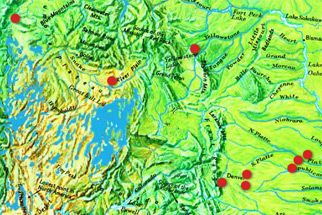Clovis People Were Not Here First
Posted by: Loren Coleman on July 14th, 2012
There has been a new discovery from the DNA analysis of the prehistoric fecal material of humans who were here earlier than the “Clovis people.” The finding calls into question the whole notion of who was in Oregon (North America) first. The Clovis people were “not alone.”

Besides the fecal material, non-Clovis artifacts have been found earlier than Clovis points, as well. Western Stemmed points from Paisley Caves date to more than 13,000 years ago–as old or older than Clovis points. Photo: Jim Barlow
Now, perhaps, eyes can be wide open to the idea that other primates, hominoids, and hominids existed in North America at the same time as so-called Native Americans, Native Canadians, and First Peoples Inuits and Eskimos too!

Explore the pre-Clovis sites here.

Was one of these kinds of pre-Clovis hominoids known as Sasquatch?
About Loren Coleman
Loren Coleman is one of the world’s leading cryptozoologists, some say “the” leading living cryptozoologist. Certainly, he is acknowledged as the current living American researcher and writer who has most popularized cryptozoology in the late 20th and early 21st centuries.
Starting his fieldwork and investigations in 1960, after traveling and trekking extensively in pursuit of cryptozoological mysteries, Coleman began writing to share his experiences in 1969. An honorary member of Ivan T. Sanderson’s Society for the Investigation of the Unexplained in the 1970s, Coleman has been bestowed with similar honorary memberships of the North Idaho College Cryptozoology Club in 1983, and in subsequent years, that of the British Columbia Scientific Cryptozoology Club, CryptoSafari International, and other international organizations. He was also a Life Member and Benefactor of the International Society of Cryptozoology (now-defunct).
Loren Coleman’s daily blog, as a member of the Cryptomundo Team, served as an ongoing avenue of communication for the ever-growing body of cryptozoo news from 2005 through 2013. He returned as an infrequent contributor beginning Halloween week of 2015.
Coleman is the founder in 2003, and current director of the International Cryptozoology Museum in Portland, Maine.










From what I’ve read, the fossil poo is 14300 years old, but the non-Clovis tools are about 12800 years old. Without knowing the error bars on those numbers, it’s hard to be sure, but that’s an estimated difference of 1500 years. It’s not a slam dunk that the two finds are in any way related.
Regardless, it does show that there was another culture in America contemporary with the Clovis people. Unfortunately, the Western Stemmed projectile culture was already known; this just pushes back the earliest date at which they are known to have been here.
I think from a cryptozoological point of view, the article Hominins did not need boats to settle islands is more interesting.
By the rate we’re going, maybe in another 50 years it will be accepted there were humans living in America 50,000 years ago, and after another 100 years we’ll be ready to accept there were other hominids living here 250,000 years ago.
Sadly, I do not think this discovery will do anything to encourage the scientific community to have a more open mind to the potential existence of a ape species native to North America. Earlier cultures, yes. But there is no evidence of an ape alongside this material. And that would be what is needed for a fossil finding to impact the debate. We would need actual ape fossils.
I don’t know why you think this has anything to do with Bigfoot. That’s ridiculous. *If* there was a species of large, hairy, non-human, bipedal primate living in eastern Siberia during one of the times the Bering Land Bridge existed, it could have used the bridge to come over, or maybe some of them might have been washed out to sea, washed up on the other side, and formed a colony that way.
The problem with that hypothesis is that it is ONLY a hypothesis; it is not supported by any evidence whatsoever. We have at least sightings of Bigfoot and Bigfoot-like creatures from all over the world, but that evidence only goes back a few centuries (in oral folklore) or a few millenia (if you want to count things like the story of Enkidu). There are obviously no surviving oral or literary records of such beings from Siberia 13000 years ago, and there are no known fossils of candidates from there, either. Gigantopithecus is poorly understood; it was a large, non-human primate, but whether it was bipedal is strictly guesswork, and its range is not known to have extended that far north.
This leaves us with no more evidence of a Sasquatch migration with the Clovis or Western Stemmed cultures than of Bigfoot arriving by flying saucer, as some would have it, or being a spirit of the forest with no permanent physical form.
At any rate, a lot of animals obviously did cross from America to Eurasia or from Eurasia to America, many of them long before any plausibly suggested first human migration. If you want a ray of hope, those are probably better analogues than Homo sapiens.
At any rate, a lot of animals obviously did cross from America to Eurasia or from Eurasia to America, many of them long before any plausibly suggested first human migration. If you want a ray of hope, those are probably better analogues than Homo sapiens. While I think there are plausible global evidences for Bigfoot’s existence (sightings, footprints, images etc) as others have mentioned without non-human (ape/hominoid) fossil evidence there is little foundation for the existence of a North American ape aka bigfoot.
My gut feeling is that the odds of Bigfoot being a real, flesh-and-blood ape are too low to be optimistic but too high to conclude against it altogether.
The odds of a real Yeti are perhaps even higher, due to the long record of apes in Asia, and the odds for an Orang Pendek are much higher, especially given the existence of orangutans and (recently) Homo floresiensis nearby.
But you’re right; until it can be shown that there really is an ape that fits the description of Bigfoot, it makes no sense to ask if it migrated to North America 13,000 years ago, 50,000 years ago, or a million years ago.